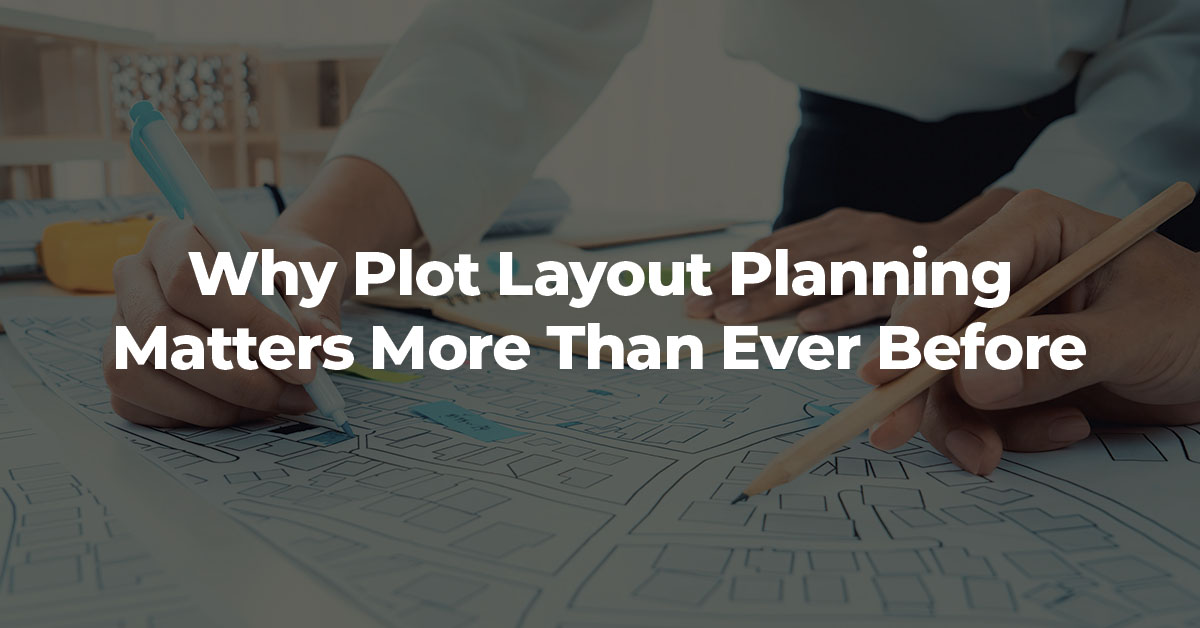
Why Plot Layout Planning Matters More Than Ever Before
Anyone scanning land for sale in Chennai today will notice how uneven the market has become. A large plot alone doesn’t guarantee comfort or profit; what shapes real value is the residential plot layout beneath it. When roads cut across a site without regard for gradient or wind flow, problems follow: later water stagnation, poor ventilation, and awkward access. A sound layout prevents those mistakes before they appear. It balances utility corridors, open zones, and movement paths so the land continues to work well long after it’s sold. In a fast-growing city, these early decisions decide whether a neighbourhood feels orderly or congested ten years from now. That is why layout planning now carries more weight than size or frontage ever did.
The Foundation of Good Urban Design
In any residential land development, the first discipline is how the land itself is organised. A real estate plot layout, if drawn with care, sets the order for everything that follows. Roads come first, not just as access routes but as the structure that defines movement, safety, and service entry. When widths, turns, and junctions are proportioned to actual use, traffic finds its rhythm without constant correction. Drainage must be planned with equal attention; the slope of each road decides whether rainwater leaves the site or lingers. Small details, like the depth of side drains or the fall direction of a cul-de-sac, make a measurable difference during monsoons. Power and water lines should be traced in open, logical corridors so that future maintenance does not disturb built areas. A good layout reads almost like handwriting, unforced, practical, and shaped by how people will live there rather than how the map looks on paper.
How Layout Planning Impacts Everyday Living
Homeowners rarely notice the finer points of planning, yet those details shape how comfortably they live. In any approved residential community, the value of plot layout approval becomes visible in everyday routines how sunlight enters a room, how air moves across corridors, or how easily children walk to a park. When homes are aligned with the sun’s path, interiors stay cooler, reducing the need for constant air-conditioning. In developing areas like real estate in Poonamallee, such alignment also preserves natural light and ventilation despite dense surroundings. The street pattern decides more than traffic; it defines how neighbours meet and how noise travels. Small open courts and walkways lower the heat and invite casual movement. Even the angle of a driveway or the position of a footpath influences how freely people use their space. A well-planned layout never demands attention; it simply makes daily life function without friction.
Environmental and Regulatory Considerations
In residential land development, rules and ecology often pull in opposite directions, yet both decide how long a project will last. A real estate plot layout that follows the land’s shape instead of forcing it usually stands the test of time. Before drawings reach the approval desk, the ground itself must be read to determine its slope, drainage lines, and soil behaviour after rain. If those are ignored, the cost of correction later is far higher than early adjustment. Green strips, open wells, and native trees aren’t cosmetic; they keep the temperature down and help the soil breathe. Regulations only confirm what good planning already respects: distance between structures, width of internal roads, proportion of built and open land. When design grows from these observations rather than rules alone, it moves through approvals smoothly and gives buyers quiet confidence that the layout will hold steady no matter how the surroundings change.
Economic Logic Behind Smart Layouts
Every development begins with numbers before drawings take shape. A residential plot layout decides how land earns its value. Each bend, junction, or service line consumes money and space. When these are positioned with care, the land functions efficiently, balancing saleable area, movement, and comfort without burdening the project with hidden costs. A layout that passes plot layout approval smoothly usually reflects this discipline, logical road widths, balanced open areas, and proper service corridors. Buyers recognise this balance even if they cannot explain it; the plots feel proportionate, construction becomes simpler, and resale remains strong. For a developer, the savings are measurable. Fewer bends and shorter service lines reduce the expense of paving, drainage, and cabling. Over time, these decisions influence maintenance budgets and community charges. The economics of land planning are quiet but constant; good geometry and clear thinking save money every year, long after the project is sold.
Risks of Poor Plot Layout Planning
Poor planning in a residential plot layout leaves marks that time only deepens. Roads end up misaligned, open spaces shrink, and essential services get squeezed into leftover corners. In fast-growing areas such as plots in Valarpuram, these mistakes show that quickly drainage lines overflow during rain, and irregular plot angles make house construction difficult. What looks like a small drafting shortcut becomes a structural flaw once building begins. Fixing such errors later usually means breaking paved roads or shifting buried lines work which costs several times more than doing it right initially. It also weakens buyer trust and unsettles property values. A well-qualified planner prevents such losses by reading the site correctly and translating that understanding into a workable layout. Early investment in competent design saves money, protects resale potential, and keeps a neighbourhood functional long after completion.
Iyra Properties’ Approach to Layout Planning
Before any drawing begins, the Iyra Properties team spends days walking the land. Soil is tested, but more importantly, its behaviour in rain and heat is watched. Wind direction is noted at different hours, and routes already used by locals are marked for possible access. A residential plot layout develops from these field notes, not from a fixed template. The plan keeps roads aligned with the natural slope so that water finds its own course. Corners that catch a steady breeze are left open for small parks or shared spaces. Engineers handle the measurements; architects make sure movement and proportion feel right. When the file goes for plot layout approval, it rarely needs revision since the design already respects topography and by-laws. The result is simple land used wisely, with every turn and boundary grounded in real observation rather than computer precision.
Conclusion
Every city expands in patterns set long before the first building rises. A sound layout keeps that growth steady and liveable. In projects involving residential land for sale in Pallikaranai, this discipline matters even more, as the area balances rapid development with ecological limits. Iyra Properties treats each site as a long-term framework, not a quick subdivision. Roads, drainage, and open spaces are positioned to age well, so maintenance stays manageable decades later. The company’s method avoids guesswork and lets natural contours guide design. What emerges are plots ready for present needs yet flexible enough for future change—land shaped to support real life, not just construction drawings.

 Aadya – Thoraipakkam
Aadya – Thoraipakkam


